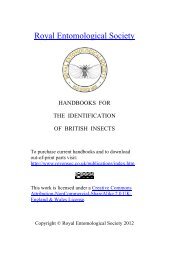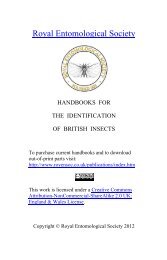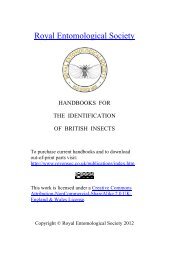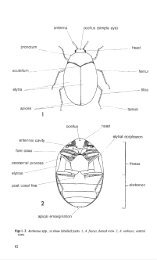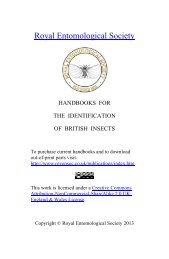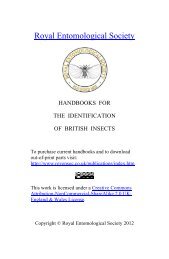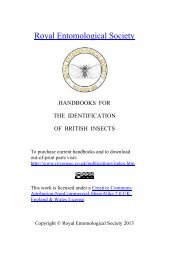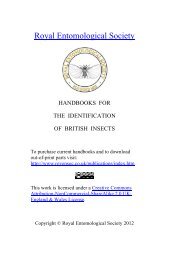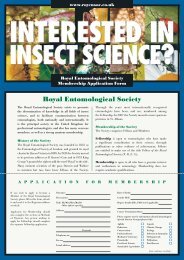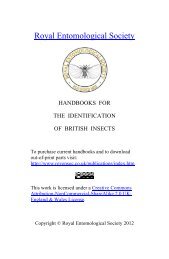Vol 10 Part 14. An introduction to the immature stages of British Flies ...
Vol 10 Part 14. An introduction to the immature stages of British Flies ...
Vol 10 Part 14. An introduction to the immature stages of British Flies ...
Create successful ePaper yourself
Turn your PDF publications into a flip-book with our unique Google optimized e-Paper software.
Biology and morphology <strong>of</strong> <strong>the</strong> <strong>immature</strong> <strong>stages</strong><br />
Diptera are holometabolous insects with a complete metamorphosis <strong>of</strong> four <strong>stages</strong>:<br />
egg, larva, pupa and adult.<br />
During growth <strong>the</strong> larvae <strong>of</strong> most Diptera pass through a series <strong>of</strong> moults, <strong>the</strong> period<br />
between <strong>the</strong> moults being called ins tars. Moults that take place soon after hatching and<br />
just prior <strong>to</strong> pupation are easily overlooked but those that take place during <strong>the</strong> active<br />
feeding period are easily observed.<br />
Nema<strong>to</strong>cera usually have <strong>the</strong> largest number <strong>of</strong> moults, e.g. four instars in Culicidae<br />
and six or seven in Simuliidae. Among Brachycera, some Tabanidae have up <strong>to</strong> nine<br />
instars and may take up <strong>to</strong> two years <strong>to</strong> complete <strong>the</strong>ir development. The maggots <strong>of</strong><br />
Cyclorrhapha usually have three instars and most feeding and growing is done in <strong>the</strong><br />
third instar.<br />
Some larvae <strong>of</strong> Cecidomyiidae reproduce by paedogenesis, i.e. reproduction by an<br />
animal that becomes sexually mature before reaching <strong>the</strong> adult form . In this method <strong>of</strong><br />
reproduction a few (up <strong>to</strong> about 35) large eggs are produced which can be seen through<br />
<strong>the</strong> larval cuticle. These become larvae and feed on <strong>the</strong>ir parent larva from inside (fig.<br />
118). This condition can continue for several generations without <strong>the</strong> appearance <strong>of</strong> an<br />
adult. These midges (e.g. Mias<strong>to</strong>r) thus reproduce like aphids and remain in <strong>the</strong>ir<br />
birthplace producing a great mass <strong>of</strong>larvae which may be found under <strong>the</strong> bark <strong>of</strong>logs.<br />
Eventually <strong>the</strong> daughter larvae will cease <strong>to</strong> produce eggs and pupate normally. Both<br />
sexes are produced in this way though <strong>of</strong> course all <strong>of</strong>fspring <strong>of</strong> one larva are <strong>of</strong> <strong>the</strong><br />
same sex as <strong>the</strong> parent larva. These paedogenetic larvae do not develop a sterna! spatula<br />
but it reappears when pupation is imminent which confirms <strong>the</strong> function <strong>of</strong> this structure<br />
as a prerequisite <strong>to</strong> pupation. Pupal paedogenesis is also known in <strong>the</strong> <strong>British</strong><br />
species Henria psalliotae Wyatt, a pest <strong>of</strong> mushrooms. This reproductive pupa is called<br />
a hemipupa (Wyatt, I. J., 1961).<br />
Some Chironomidae appear <strong>to</strong> be paedogenetic but actually <strong>the</strong> adult female lays her<br />
eggs while she is still inside <strong>the</strong> pupal skin and is thus a pharate adult.<br />
In most Nema<strong>to</strong>cera and Brachycera <strong>the</strong> fully fed larvae form pupae but in<br />
Cyclorrhapha <strong>the</strong> last (third) instar larva forms a puparium from <strong>the</strong> last larval skin<br />
inside which it pupates. Stratiomyidae are exceptional in <strong>the</strong> Brachycera in not shedding<br />
<strong>the</strong> last larval skin when <strong>the</strong>y pupate but this appears <strong>to</strong> be a protective device unrelated<br />
<strong>to</strong> <strong>the</strong> cyclorrhaphous puparium. Some Nema<strong>to</strong>cera also pupate inside <strong>the</strong> last larval<br />
skin, e.g. Mayetiola and Chor<strong>to</strong>myia (Cecidomyiidae), some Sca<strong>to</strong>psidae, Pen<strong>the</strong>tria<br />
holosericea Meigen (non-<strong>British</strong>- Bibionidae) and <strong>the</strong> non-<strong>British</strong> Perissomatidae.<br />
Eggs<br />
The eggs <strong>of</strong> flies are generally oval or spindle-shaped, white or pale yellow and<br />
relatively featureless <strong>to</strong> <strong>the</strong> naked eye. Under <strong>the</strong> microscope many are seen <strong>to</strong> have a<br />
sculptured surface and some also have horns, stalks or a raised network <strong>of</strong> ridges. These<br />
surface features are largely respira<strong>to</strong>ry adaptations <strong>to</strong> prevent <strong>the</strong> eggs from drowning<br />
after rain and function as a respira<strong>to</strong>ry plastron which holds a thin film <strong>of</strong> air, as in<br />
many aquatic beetles and bugs (Hin<strong>to</strong>n, 1961 ). The ornamentation <strong>of</strong> an egg increases<br />
surface tension and may cause it <strong>to</strong> float, and <strong>the</strong> eggs <strong>of</strong> aquatic species may have more<br />
elaborate floatation devices (e.g. mosqui<strong>to</strong>es, figs 976-978). At <strong>the</strong> head end <strong>of</strong> <strong>the</strong> egg<br />
is <strong>the</strong> micropyle (fig. I 023), an opening for <strong>the</strong> admission <strong>of</strong> sperm.<br />
The largest number <strong>of</strong> eggs (c. 2,000) is produced by some aquatic flies whose larvae<br />
suffer enormous mortality from predation (e.g. Chironomus plumosus L.). Female<br />
blow-flies (Calliphora) lay about 300 eggs, usually in several small batches. The female<br />
housefly (Musca domestica L.) lays eggs singly in small or large batches at <strong>the</strong> rate <strong>of</strong><br />
I 00-150 per day up <strong>to</strong> I ,000. At <strong>the</strong> o<strong>the</strong>r extreme, Hippoboscidae and o<strong>the</strong>r Pupipara<br />
mature only one egg at a time, nurture it internally and eventually deposit a fully<br />
24




